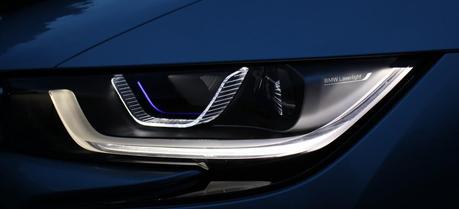 BMW laser headlight technology will be celebrating its world premiere as of autumn 2014. (Credit: BMW Group)
BMW laser headlight technology will be celebrating its world premiere as of autumn 2014. (Credit: BMW Group)BMW Laserlights laser headlight technology will be celebrating its world premiere as of autumn 2014. This efficient light source is arriving on the roads in a production car for the first time to provide the high beam in the BMW i8 headlight.
In the laser headlight, the beams of light are bundled together to attain a luminous intensity 10 times greater than conventional light sources, such as halogen, xenon or LED, according to the press release by BMW. BMW Laserlights have a visual range of up to 600 meters (approx. 2000 ft.), twice that of a headlight with conventional light technology.
The light-emitting surface area of a laser diode is one hundred times smaller than that of a conventional LED, which measures one square millimeter. Consequently, a far smaller reflector is needed for laser light. In the case of the BMW i8, a diameter of less than 30 millimeters is sufficient, saving installation space in the vehicle and opening up the potential for weight savings. By way of comparison: xenon light requires a reflector/lens diameter of around 70 millimeters and halogen light 120 millimeters in order to achieve an adequate light output and range for the respective lighting technology.
The laser headlight technology is quite efficient, providing a reduction in energy consumption of
some 30 per cent. Laser light therefore helps to somewhat improve the vehicle’s overall efficiency and reduce CO2 emissions.
BMW Laserlights take the coherent and monochromatic blue laser beams and transform them into harmless white light. This is done by using special lenses to direct the beams emitted by three high-performance laser diodes onto a fluorescent phosphorous substance inside the laser light source. This fluorescent substance converts the beams into a white light, still with a very high intensity. Following conversion of the laser beams, the harmless, dispersed light is projected forward by the headlight unit.

